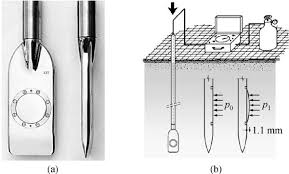Flat Dilatometer Test (DMT)
The DMT consists of a stainless steel blade with a thin flat circular expandable steel membrane on one side. When at rest, the external surface of the membrane is flush with the surrounding flat surface of the blade. The blade is connected to a control unit on the surface by a nylon tube containing an electrical wire and is pushed into the ground using the CPT rig. At 0.2m depth intervals pushing is stopped and the membrane is inflated by means of pressurized gas. Readings are taken of the A pressure required to just begin to move the membrane and of the B pressure required to move its  centre 1mm horizontally into the soil. An optional C pressure can also be measured. These readings are automatically recorded and saved by the DMT software.
centre 1mm horizontally into the soil. An optional C pressure can also be measured. These readings are automatically recorded and saved by the DMT software.
The main application of the DMT is to estimate settlements and operative moduli, both in sands and clays, and the undrained shear strength in clay.
DMT provides a number of important soil parameters including: Material Index (ID), Horizontal Stress Index (KD), Dilatometer Modulus (ED), Lateral Pressure Coefficient (KO), Undrained Shear Strength (CU), Sandy Soil Internal Friction Angle (Φ), Over-Consolidation Ratio (OCR) and Constrained Modulus (M).
For more information on DMT please refer to:
You must be logged in to post a comment.

+ There are no comments
Add yours